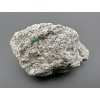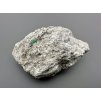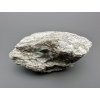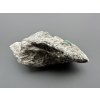Emerald – Habachtal, Austria
Locality: Habachtal, Austria
Weight: 78g
Dimensions: 7 x 4,1 x 2,5 cm
Dimensions of the crystal: 6 x 3 x 3 mm
Note: The natural substrate for emeralds is talc rock
| Category: | Austrian emeralds |
|---|
Austrian emeralds come mainly from the Habachtal region in the Alps, which is one of the few emerald deposits in Europe. The Habachtal is located in the High Tauern National Park in Austria and the emeralds here are unique in their green colour, which can be intense but is often slightly yellowish. Emeralds from Habachtal are prized for their quality among collectors and jewellers alike.
Emeralds were formed here as a result of geological processes involving high pressure and temperature over many millions of years. These conditions led to the formation of crystals in the underlying rocks rich in beryllium and chromium, which give emeralds their distinctive colour. Geologically, Habachtal emeralds are typically associated with biotite-rich shale rocks. The deposit lies at an altitude of around 2 200 metres and access is difficult, which adds to the difficulty of extracting them. In addition to emeralds, other minerals such as aquamarine and tourmaline can be found in the area, making Habachtal a popular destination for mineral collectors.
Today, Habachtal also offers hiking "emerald trails." In addition to tourists who travel to Habachtal for the opportunity to find their own emeralds, commercial mining is also taking place in the area. However, the mines in Habachtal are relatively small and production is limited, which adds to the exclusivity of these emeralds.
Accompanying mineral Emeraldite
In addition to emeralds, emeraldite, a type of rock rich in minerals similar to emeralds, is also abundant in Habachtal, Austria. Emeraldite is formed in green shales and is often used as a decorative stone due to its green colour, which can vary in shades depending on the composition of the particular sample. Although emeraldite is not technically the same as gem emerald, it contains minerals such as actinolite and chlorite, which give it a specific, rich green colour that resembles emeralds.
Curiostities: Most often the term "emeraldite" is associated with alpine rocks, where it is used as a local name for stones with long, green crystals of actinolite, making the name traditional but unofficial. This alpine 'emeraldite' has a varied texture, with omphacite and actinolite providing the green colour, and jade, albite, quartz and, due to geological changes, quartz may also be present in the white part.












